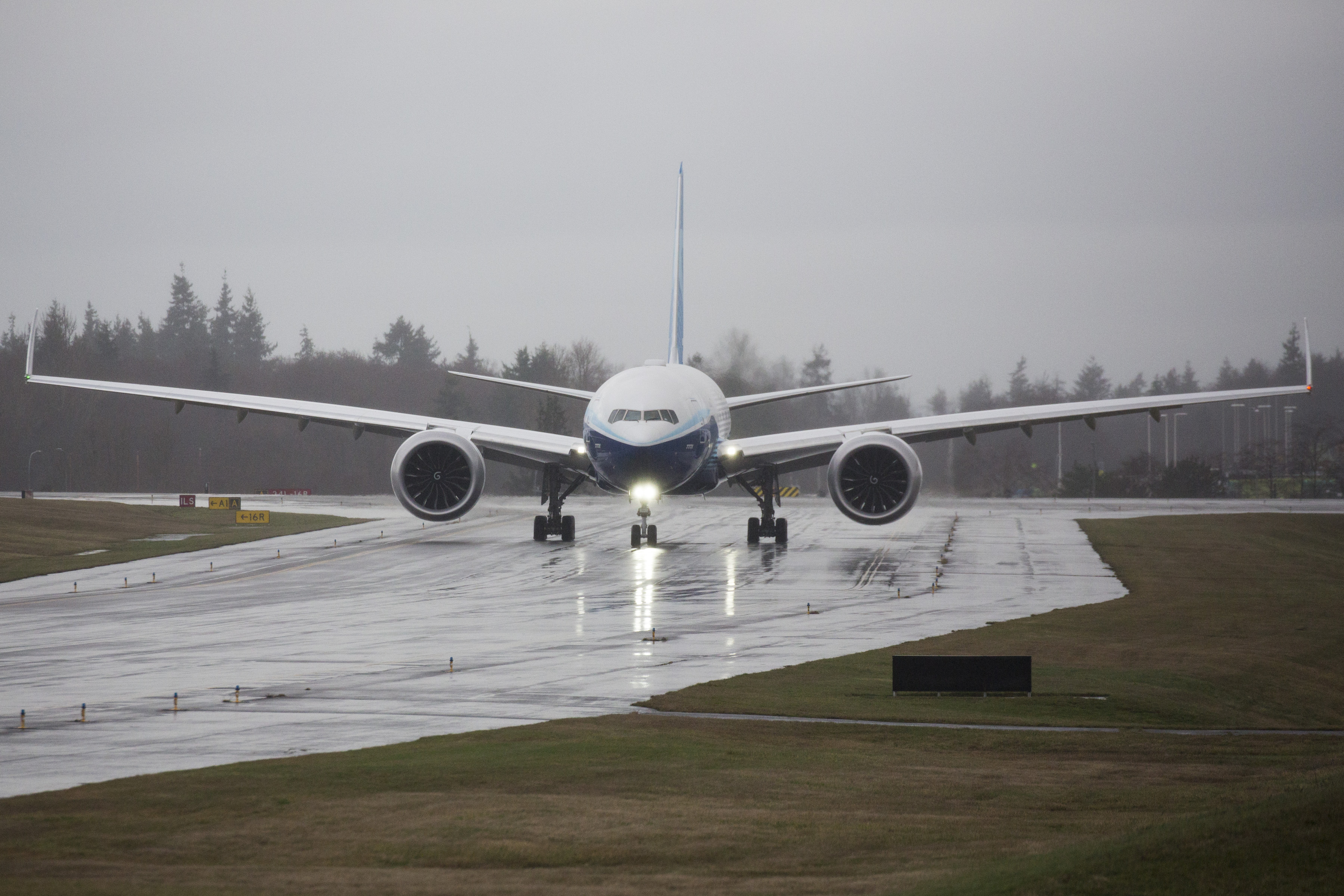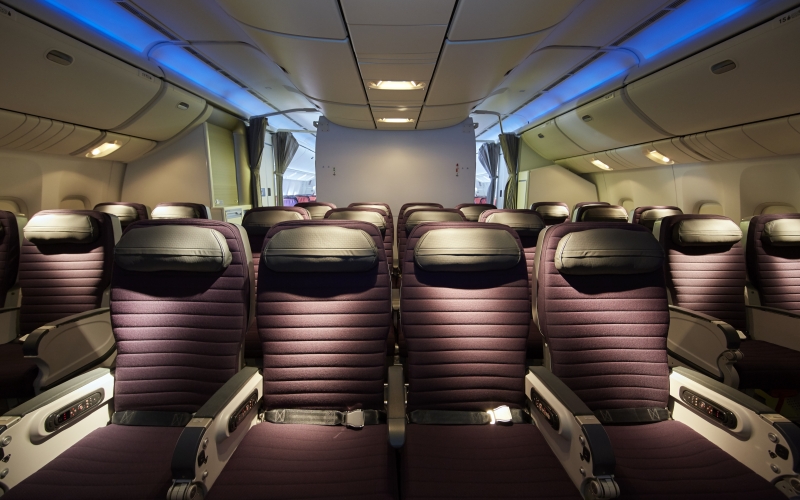Today marked a milestone for the Boeing 777X program. I was watching the live stream to see the 10:10 am take off from runway 34L at Paine Field (PAE). The aircraft completed a four-hour low-speed functionality test for this initial test flight.
First Test Flight
This first flight was a basic functionality test flight at low speed and low altitude. The crew consisted of just the pilot and copilot as a full complement of engineers will be added in subsequent flights. Here is the test route for today’s maiden test flight.
The first flight required the aircraft to keep the flaps and landing gear extended. For this, a slow speed flight plan is required keeping the aircraft under 300 knots. The flight altitude was at 15,000 feet with an accent late in the flight.
The first #777X flight test airplane is about to get painted. Join us #live today at 10 a.m. PST (18:00 UTC) from Everett, Wash.! We'll share a rare glimpse inside a #Boeing paint facility and hear from our team about what's next for the 777X test airplane.
A day after high winds in Everett forced postponement of the first flight of Boeing’s big new 777X, the largest twin-engine passenger plane in the world completed that milestone successfully on. Whilst the first flight of the Boeing 777x is a cause for excitement, Boeing must be feeling the pressure of getting this completely right in light of the 737 MAX situation. But enough of that. The test flight lasted four hours out over the Pacific Northwest, a major milestone and the beginning of a very rigorous aircraft certification program.
The aircraft landed at 2:00 pm PST at Boeing Field (BFI) in Seattle on runway 14 Right. From there, it taxied on taxiway Bravo to the hangar.

Why This Test Is So Critical
First things first, Boeing needed some good news and a morale booster. Thousands of employees were on hand to witness this first test flight.
Even though the 777 has been flying for over 20 years, there are new features and systems onboard that need testing prior to FAA certification. The wings feature retractable wingtips that must be extended and locked prior to the takeoff roll. On the landing roll, the computer retracts the wingtips when the landing speed reaches 50 knots.
Another new feature to be tested is the new GE 9X engines. These new engines are the largest production turbofan engines with the fan disk measuring 11 feet in diameter.
What Is Involved In The Testing Program
Before the Boeing 777X can receive an airworthiness certificate from the FAA, it will have to undergo an extensive testing program. The testing programs consist of three phases:

- Preparation – getting the aircraft ready for flight and doing ground testing on engines and taxi tests,
- Execution – flying the aircraft like today to check for anomalies and flight handling characteristics and
- Data collection and evaluation – this is where engineering looks at the actual flight data to see if it matches the computer models used for design.
Testing results from the flight crew are evaluated for a variety of parameters:
- Static and dynamic pressures,
- Vibrations,
- Aircraft handling,
- Performance of control surfaces and
- Engine performance.
You can see in the photo above the pressure monitoring unit is trailing the top of the tail. The static and dynamic pressures across the entire aircraft are monitored for evaluation. These evaluations are used to verify that computer data used during the design phase are correct.
What’s Next For The Testing Program
The testing program for a new aircraft could take years. Since this aircraft is a follow-on to an existing program, the testing program should only take months to complete. After a few flights with just the pilots, an engineering team will be on board monitoring the test stations aboard the aircraft. There is no passenger interior installed, there are the test stations and water barrels. The water barrels are used if there is a weight and balance issue with a test flight. The testing phases will include:
- Airworthiness testing,
- Systems testing,
- Performance testing and
- FAA certification testing to obtain the required airworthiness certificate for passenger flights.
A Milestone For The 777X Program
Today is just the beginning of the flight testing program. There will be months of flight tests ahead with each test getting more involved in the flight envelope. There will testing to the extremes for extreme temperature operations, testing flight parameters such as rejected takeoff, wet landing to pressure and structual tests like a tail strike due to over-rotation on takeoff.
Today’s flight was a success. Now the real work begins so this aircraft can receive FAA certification to enter airline service.
Read This Next
After two failed attempts, called off due to high winds, the latest addition to the 26-year-old Boeing 777 family has finally taken to the air. At 09:08 am, Saturday 25 January 2020, aircraft registration WH-001 started its takeoff run on runway 34 Left at Paine Field, Everett. With an 8 knot tailwind, broken clouds at 3,000 feet with 6 miles visibility, the largest twin-engine jet took a mere 30 seconds to become airborne. Applause and cheering from the crowd was drowned out by the worlds biggest jet engines, the GE Aviation GE9x.
Maiden flights of new airliners don’t happen very often, maybe once or twice a decade. Whilst the first flight of the Boeing 777x is a cause for excitement, Boeing must be feeling the pressure of getting this completely right in light of the 737 MAX situation. But enough of that.
777x First Flight Time
The test flight lasted four hours out over the Pacific Northwest, a major milestone and the beginning of a very rigorous aircraft certification program. Before the aircraft can be delivered to airlines and begin carrying passengers, it has to go through a certification process. This is done with the F.A.A. (Federal Aviation Administration) and then no doubt with other agencies such as E.A.S.A. (European Union Aviation Safety Agency) before it can fly to, or overfly those regions. By current estimates, Boeing expects to be in a position to start delivering the first aircraft to customers in 2021. The first of those is expected to be Emirates. The order book for the 777x stands at 309 airframes with a list price of US $442M per aircraft. Of course, this is not necessarily what airlines will pay as they will have negotiated with Boeing for discounts around things like, number of aircraft ordered, or being the launch airline. Nevertheless, the sooner Boeing starts delivering, the sooner the income for this project will start.
So after 26 years of 777s (Tripple Sevens), what is so special about the 777x? Well, the original 777 was a step forward in its day, being computer designed it brought a lot of new ideas to the airliner design table. The 777x is carrying on that tradition by using technologies that have been tried and tested in the Boeing 787 Dreamliner. This includes using more composite materials in its construction, to make use of lighter stronger materials as well as materials which are far less susceptible to corrosion. Larger windows and an updated passenger cabin will be great news for passengers on this aircraft that Boeing maintains is the most efficient twin-engined airliner in the world.
___________________________________________________________________
The standout feature is the folding wingtip………
___________________________________________________________________
The stand out feature, however, is the folding wingtip. This feature, until now, was typical of fighter aircraft that were assigned to aircraft carriers. To save space when the aircraft was stored below decks, its wings would be folded upwards and thereby reducing the side to side space required for its storage. This is a concept that Boeing went with. To create the largest twin jet in the world, that is required to fly further than the previous version, was going to require a wing that gave more lift than the previous version. Winglets could have solved the problem to some extent, but it has been found that a longer tapered wing gives more optimal lift. The Boeing 787 and the Boeing 747 8 are testament to Boeing’s findings in this area.
So why folding wingtips? Well, let’s look at the Airbus A380. When it was introduced in the early 2000s, airports were required to make adjustments to gate areas to enable a much wider aircraft to be accommodated. They had to be “A380 Ready” before that airliner could land there. A huge upheaval and expense but it was seen as the new future and therefore was seen as an investment in that future. We now know of course that the days of the A380 are numbered, now that the giant twin airliners are coming of age. Boeing wanted to avoid the restrictiveness of requiring airports to upgrade to be able to handle an oversized wingspan. They wanted the 777x to be able to fly everywhere that the current generation of 777s can fly to. So was born the folding wingtip idea. The wingtips allow the 777x to change from a wingspan of 235 feet in the air down to 213 feet on the ground.
As the wingtips are a totally new technology in the passenger airliner space, the F.A.A. has come up with a set of 10 conditions that have to be satisfied before certification can take place. Boeing has stated that the non-deployment of the wingtips on takeoff can lead to catastrophic results. This is logical, as a fully laden aircraft, depends on the lift that those wingtips provide. If you suddenly have smaller wings than required, you are going by road with tragic results. The 10 conditions are designed to put fail-safes in place to
_________________________________________________________________
… you are going by road with tragic results……..

_________________________________________________________________
prevent the non-deployment of wingtips on takeoff as well as the failure of the wingtips to stay in place during flight. These conditions revolve around a comprehensive warning system to alert the crew to the fact they are attempting takeoff without the wingtips deployed. In addition, if that is ignored, there is the ability for the aircraft to prevent takeoff until wingtips are deployed. With every new technology comes a whole raft of things to consider and conditions to be tested for.
Like the Boeing 787 Dreamliner which started its early days as the 7E7, the 777x will no doubt be dropped in favour of the actual variant names of 777-8 and 777-9. Some basic statics on the two models are as follows:
Be sure to visit our Boeing 777x page for more details.
At 251 feet, the Boeing 777-9 will be the longest commercial aircraft in the world.
777x First Flight Video

Boeing 777x First Flight Schedule
The road to this first test flight has not been a smooth one. From the time that the 777x was first rolled out of the hangar in March 2019, it was found that the new GE9x engine experienced excessive wear when run. In September when the wing stress testing was done, there was an explosive decompression event when a tear appeared in the fuselage. The manufacturing of the 777x was to be done in a fully automated assembly line by robots. Challenges in this area have forced Boeing to revert back to the traditional human-driven process.
777x First Flight Youtube
The 777x is in the air at last. We certainly look forward to watching its progress toward certification.